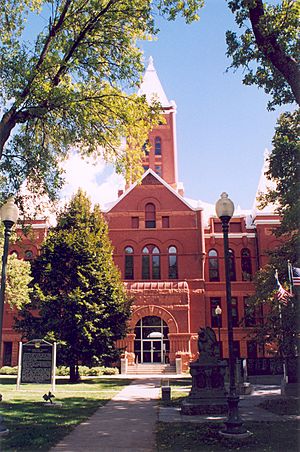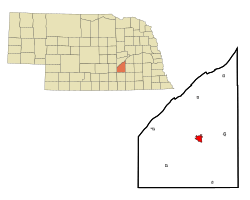Aurora, Nebraska facts for kids
Quick facts for kids
Aurora, Nebraska
|
|
|---|---|
|
City
|
|

Hamilton County courthouse in Aurora
|
|

Location of Aurora, Nebraska
|
|
| Country | United States |
| State | Nebraska |
| County | Hamilton |
| Incorporated | July 3, 1877 |
| Government | |
| • Type | Council/Mayor |
| Area | |
| • Total | 3.31 sq mi (8.58 km2) |
| • Land | 3.28 sq mi (8.49 km2) |
| • Water | 0.03 sq mi (0.09 km2) |
| Elevation | 1,795 ft (547 m) |
| Population
(2020)
|
|
| • Total | 4,678 |
| • Density | 1,427.09/sq mi (550.93/km2) |
| Time zone | UTC-6 (Central (CST)) |
| • Summer (DST) | UTC-5 (CDT) |
| ZIP code |
68818
|
| Area code(s) | 402 |
| FIPS code | 31-02690 |
| GNIS feature ID | 2394036 |
| Website | http://www.cityofaurora.org/ |
Aurora is a city located in Hamilton County, Nebraska, in the United States. In 2020, about 4,678 people lived there. Aurora is also the county seat of Hamilton County. This means it is the main town where the county government is located.
Contents
Discovering Aurora's Past
In 1861, a person named David Millspaw became the first permanent settler in the area. This was before Aurora even existed as a town.
How Aurora Got Its Name
Hamilton County was officially formed in 1870. The town of Aurora was planned out in 1871 by David Stone. He decided to name it after his old hometown, Aurora, Illinois.
Becoming the County Seat
The main government office for Hamilton County used to be in a different town called Orville City. But in 1876, the county seat was moved to Aurora. This made Aurora an even more important place in the county.
Exploring Aurora's Location and Climate
Aurora is located in Nebraska. It covers a total area of about 3.31 square miles (8.58 square kilometers). Most of this area is land, with a small part being water.
Rainfall in Hamilton County
The amount of rain that falls in Hamilton County each year is usually between 26 and 30 inches. This measurement is based on data collected from 1971 to 2000.
Understanding Aurora's Population
The population of Aurora has changed a lot over the years. Here's how many people have lived in the city during different census years:
| Historical population | |||
|---|---|---|---|
| Census | Pop. | %± | |
| 1890 | 1,862 | — | |
| 1900 | 1,921 | 3.2% | |
| 1910 | 2,630 | 36.9% | |
| 1920 | 2,962 | 12.6% | |
| 1930 | 2,715 | −8.3% | |
| 1940 | 2,419 | −10.9% | |
| 1950 | 2,455 | 1.5% | |
| 1960 | 2,576 | 4.9% | |
| 1970 | 3,180 | 23.4% | |
| 1980 | 3,717 | 16.9% | |
| 1990 | 3,810 | 2.5% | |
| 2000 | 4,225 | 10.9% | |
| 2010 | 4,479 | 6.0% | |
| 2020 | 4,678 | 4.4% | |
| U.S. Decennial Census 2012 Estimate |
|||
Population Details from 2010
In 2010, there were 4,479 people living in Aurora. They lived in 1,781 households, which are like homes or families. About 33.7% of these households had children under 18 living with them. The average age of people in Aurora was about 40.4 years old.
Education in Aurora
Students in Aurora attend schools managed by Aurora Public Schools.
Public Schools for All Ages
- Aurora High School teaches students in grades 9 through 12.
- Aurora Middle School is for students in grades 6 through 8.
- Aurora Elementary School serves younger students from Pre-Kindergarten through grade 5.
Media Outlets in Aurora
Aurora has its own local radio station and newspaper.
Local Radio Station
- KRGY 97.3FM is the radio station that serves the Aurora area.
Community Newspaper
- The Aurora News-Register is the local newspaper for the city.
Famous People from Aurora
Many interesting people have connections to Aurora.
- Silas Reynolds Barton — A U.S. Representative from Nebraska.
- Harold Eugene Edgerton — He invented the strobe light, which is used for taking fast photos.
- Eugene Jerome Hainer — Another U.S. Representative from Nebraska.
- Bob Kremer — A state senator in Nebraska.
- Tom Kropp - A professional basketball player.
- Clarence Mitchell — A player in Major League Baseball.
- Terese Nielsen — A talented artist who creates fantasy art.
- Baylor Scheierman - A professional basketball player.
- Harry Scott Smith - An expert in insects (entomologist) and an educator.
- Ron Spencer — An artist known for his work on Magic: The Gathering cards.
- William Ledyard Stark — A politician who was part of the Populist movement.
- Marion Van Berg - A famous horse trainer who is in the Racing Hall of Fame.
Images for kids
See also
 In Spanish: Aurora (Nebraska) para niños
In Spanish: Aurora (Nebraska) para niños



